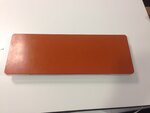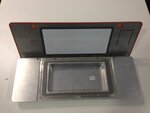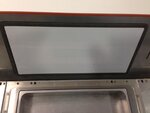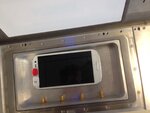Dirtyfighter
Newbie level 6
Hi everyone,
I am a young RF engineer with 3 years of experience in antenna/RF design, and I am currently struggling with what I think is an uncommon situation (well, from what I have seen doing a little search on the web :lol . I am being asked to find a way to communicate with a cell phone placed anywhere on the underside of a metal enclosure which is 200 mm in length, 110 mm in width and a little less than 30 mm in height. This metal enclosure opens by lifting the top cover; from an external point of view it can be seen as a perfect Faraday cage. Because of the dimensions of the metal enclosure, I think placing an antenna (which would have to operate over all of the four frequency bands used in cellular communications) on any of the inner face is not relevant because of the too small distance to the cell phone (comprised between a few mm and a few cm depending on where this one is located with regard to the hypothetical antenna). I might be wrong but from what I understand at such a small distance the antenna would only generate reactive near field, which the antennas embedded inside the cell phone could not "deal with".
. I am being asked to find a way to communicate with a cell phone placed anywhere on the underside of a metal enclosure which is 200 mm in length, 110 mm in width and a little less than 30 mm in height. This metal enclosure opens by lifting the top cover; from an external point of view it can be seen as a perfect Faraday cage. Because of the dimensions of the metal enclosure, I think placing an antenna (which would have to operate over all of the four frequency bands used in cellular communications) on any of the inner face is not relevant because of the too small distance to the cell phone (comprised between a few mm and a few cm depending on where this one is located with regard to the hypothetical antenna). I might be wrong but from what I understand at such a small distance the antenna would only generate reactive near field, which the antennas embedded inside the cell phone could not "deal with".
Another idea I have had is to turn the enclosure into a TEM cell, however although I have never used one I understand that they need to be large compared to the object to be tested, and normally the coupling strip (septum) is located right in the centre section of the cell which is here impossible...
Last idea, someone told me that I could try to turn the top and lower faces of the enclosure into capacitor plates. This means that the cell phone would be sitting between the plates but I am battling to figure out how it could be implemented.
So if you guys have ideas, comments, whatever... Thank you in avance !
P.S : sorry if I made mistakes, I am not a native speaker
P.S 2 : I have access to CST MS
I am a young RF engineer with 3 years of experience in antenna/RF design, and I am currently struggling with what I think is an uncommon situation (well, from what I have seen doing a little search on the web :lol
Another idea I have had is to turn the enclosure into a TEM cell, however although I have never used one I understand that they need to be large compared to the object to be tested, and normally the coupling strip (septum) is located right in the centre section of the cell which is here impossible...
Last idea, someone told me that I could try to turn the top and lower faces of the enclosure into capacitor plates. This means that the cell phone would be sitting between the plates but I am battling to figure out how it could be implemented.
So if you guys have ideas, comments, whatever... Thank you in avance !
P.S : sorry if I made mistakes, I am not a native speaker
P.S 2 : I have access to CST MS



